1990 VOLVO 240 ECO mode
[x] Cancel search: ECO modePage 2 of 143
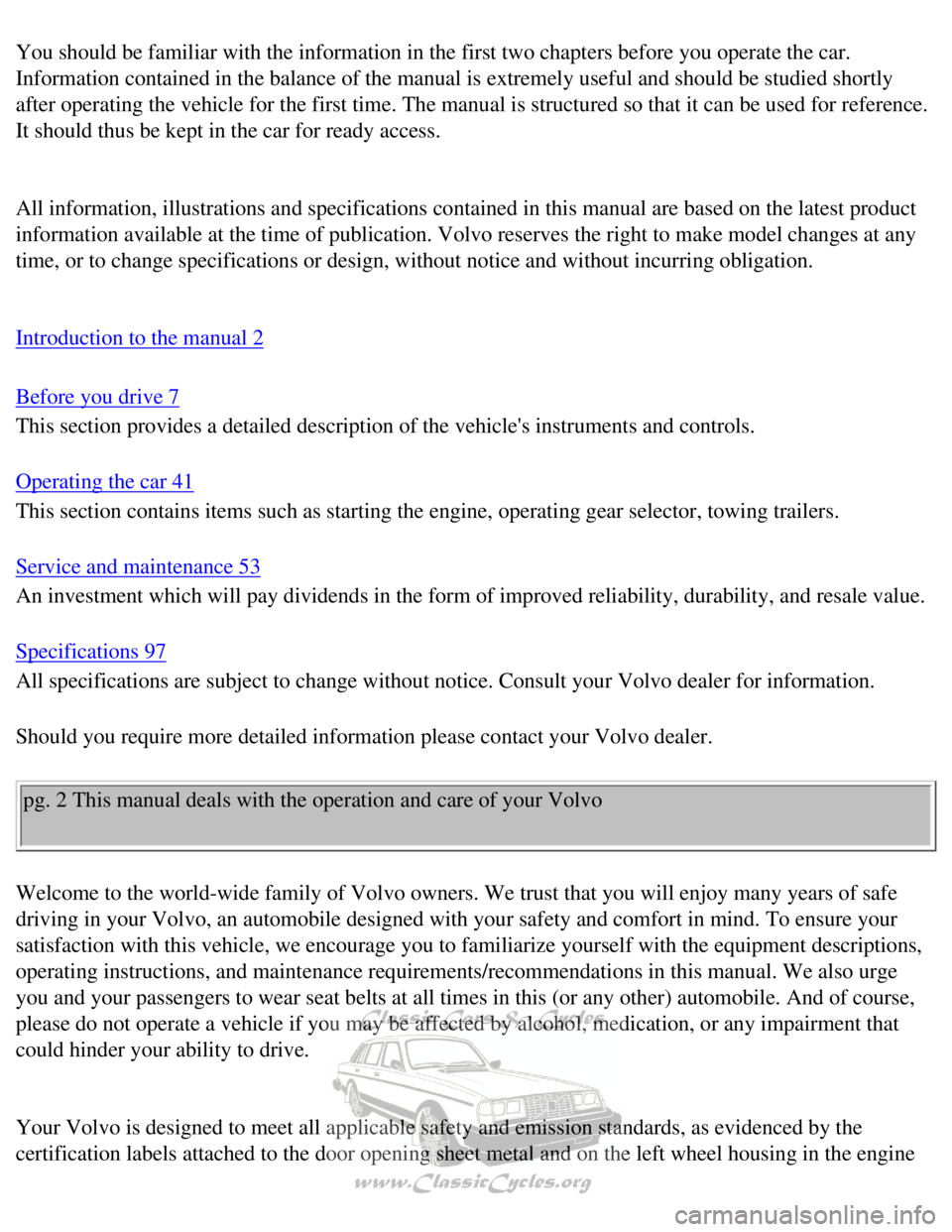
Volvo 1990 240 Model
You should be familiar with the information in the first two chapters be\
fore you operate the car.
Information contained in the balance of the manual is extremely useful a\
nd should be studied shortly
after operating the vehicle for the first time. The manual is structured\
so that it can be used for reference.
It should thus be kept in the car for ready access.
All information, illustrations and specifications contained in this manu\
al are based on the latest product
information available at the time of publication. Volvo reserves the rig\
ht to make model changes at any
time, or to change specifications or design, without notice and without \
incurring obligation.
Introduction to the manual 2
Before you drive 7
This section provides a detailed description of the vehicle's instrument\
s and controls.
Operating the car 41
This section contains items such as starting the engine, operating gear \
selector, towing trailers.
Service and maintenance 53
An investment which will pay dividends in the form of improved reliabili\
ty, durability, and resale value.
Specifications 97
All specifications are subject to change without notice. Consult your Vo\
lvo dealer for information.
Should you require more detailed information please contact your Volvo d\
ealer. pg. 2 This manual deals with the operation and care of your Volvo
Welcome to the world-wide family of Volvo owners. We trust that you will\
enjoy many years of safe
driving in your Volvo, an automobile designed with your safety and comfo\
rt in mind. To ensure your
satisfaction with this vehicle, we encourage you to familiarize yourself\
with the equipment descriptions,
operating instructions, and maintenance requirements/recommendations in \
this manual. We also urge
you and your passengers to wear seat belts at all times in this (or any\
other) automobile. And of course,
please do not operate a vehicle if you may be affected by alcohol, medic\
ation, or any impairment that
could hinder your ability to drive.
Your Volvo is designed to meet all applicable safety and emission standa\
rds, as evidenced by the
certification labels attached to the door opening sheet metal and on the\
left wheel housing in the engine
file:///K|/ownersdocs/1990/1990_240/90240_00.htm (2 of 4)12/30/2006 8:\
25:01 AM
Page 3 of 143
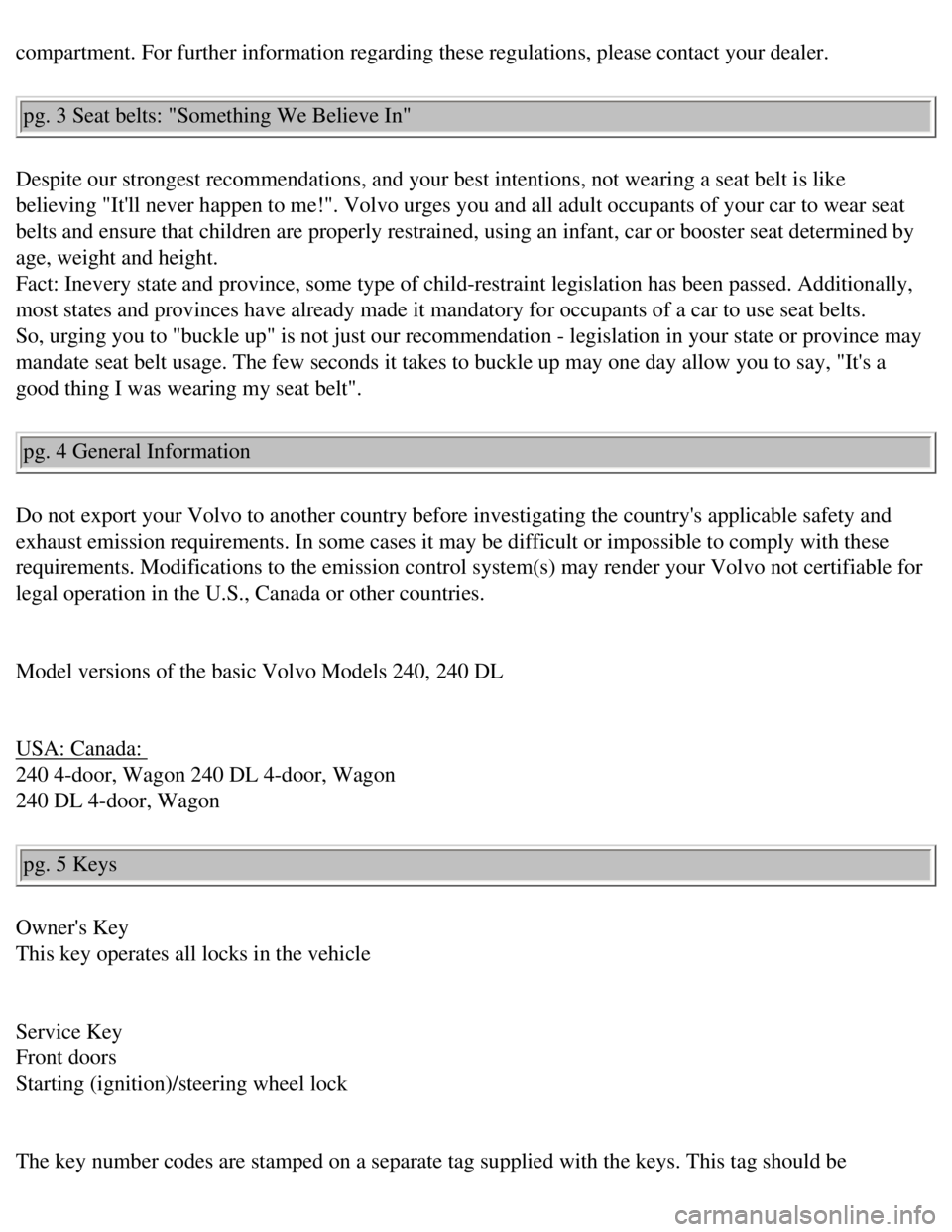
Volvo 1990 240 Model
compartment. For further information regarding these regulations, please\
contact your dealer. pg. 3 Seat belts: "Something We Believe In"
Despite our strongest recommendations, and your best intentions, not wea\
ring a seat belt is like
believing "It'll never happen to me!". Volvo urges you and all adult occ\
upants of your car to wear seat
belts and ensure that children are properly restrained, using an infant,\
car or booster seat determined by
age, weight and height.
Fact: Inevery state and province, some type of child-restraint legislati\
on has been passed. Additionally,
most states and provinces have already made it mandatory for occupants o\
f a car to use seat belts.
So, urging you to "buckle up" is not just our recommendation - legislati\
on in your state or province may
mandate seat belt usage. The few seconds it takes to buckle up may one d\
ay allow you to say, "It's a
good thing I was wearing my seat belt". pg. 4 General Information
Do not export your Volvo to another country before investigating the cou\
ntry's applicable safety and
exhaust emission requirements. In some cases it may be difficult or impo\
ssible to comply with these
requirements. Modifications to the emission control system(s) may rend\
er your Volvo not certifiable for
legal operation in the U.S., Canada or other countries.
Model versions of the basic Volvo Models 240, 240 DL
USA: Canada:
240 4-door, Wagon 240 DL 4-door, Wagon
240 DL 4-door, Wagon pg. 5 Keys
Owner's Key
This key operates all locks in the vehicle
Service Key
Front doors
Starting (ignition)/steering wheel lock
The key number codes are stamped on a separate tag supplied with the key\
s. This tag should be
file:///K|/ownersdocs/1990/1990_240/90240_00.htm (3 of 4)12/30/2006 8:\
25:01 AM
Page 18 of 143
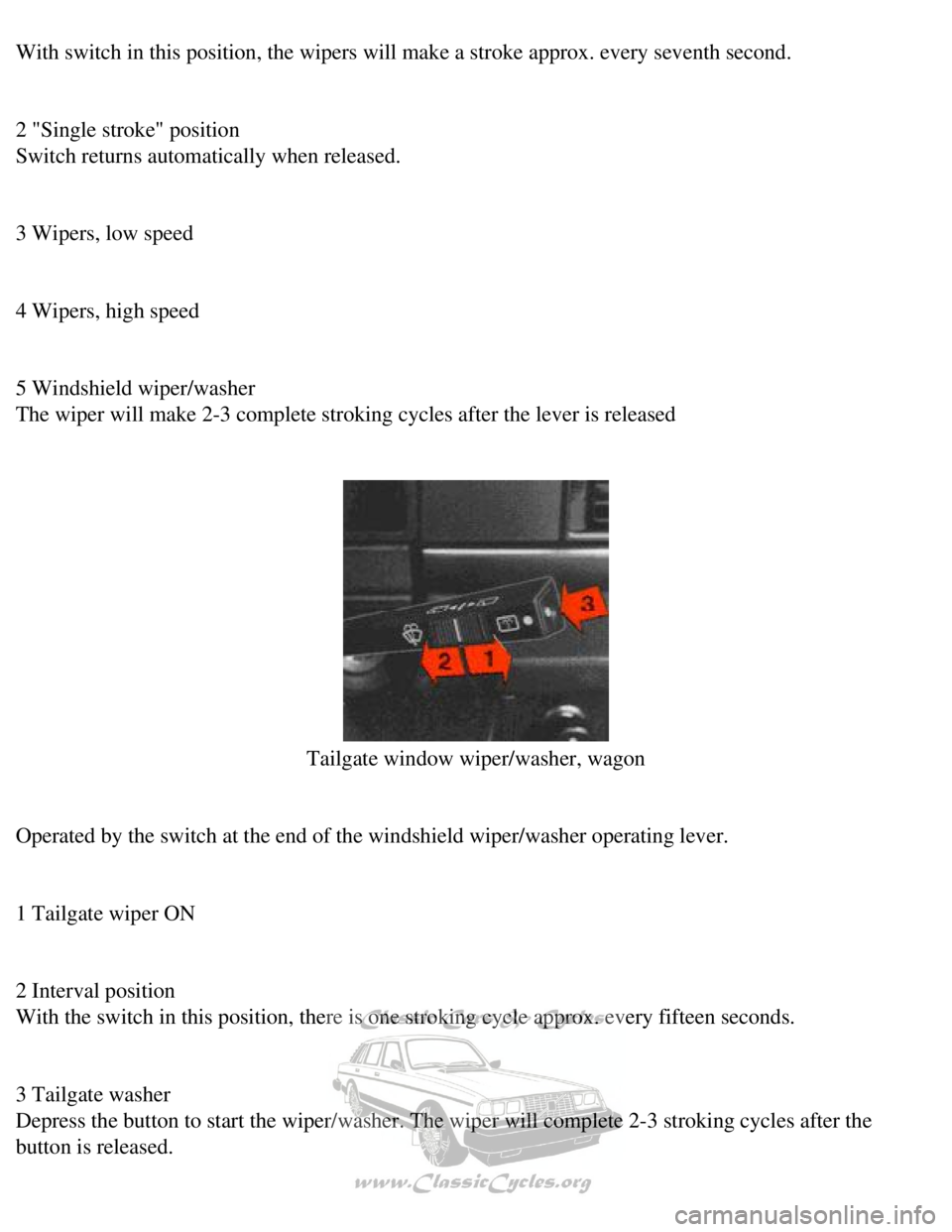
Volvo 1990 240 Model
With switch in this position, the wipers will make a stroke approx. ever\
y seventh second.
2 "Single stroke" position
Switch returns automatically when released.
3 Wipers, low speed
4 Wipers, high speed
5 Windshield wiper/washer
The wiper will make 2-3 complete stroking cycles after the lever is rele\
ased
Tailgate window wiper/washer, wagon
Operated by the switch at the end of the windshield wiper/washer operati\
ng lever.
1 Tailgate wiper ON
2 Interval position
With the switch in this position, there is one stroking cycle approx. ev\
ery fifteen seconds.
3 Tailgate washer
Depress the button to start the wiper/washer. The wiper will complete 2-\
3 stroking cycles after the
button is released.
file:///K|/ownersdocs/1990/1990_240/90240_03.htm (5 of 7)12/30/2006 8:\
25:02 AM
Page 32 of 143
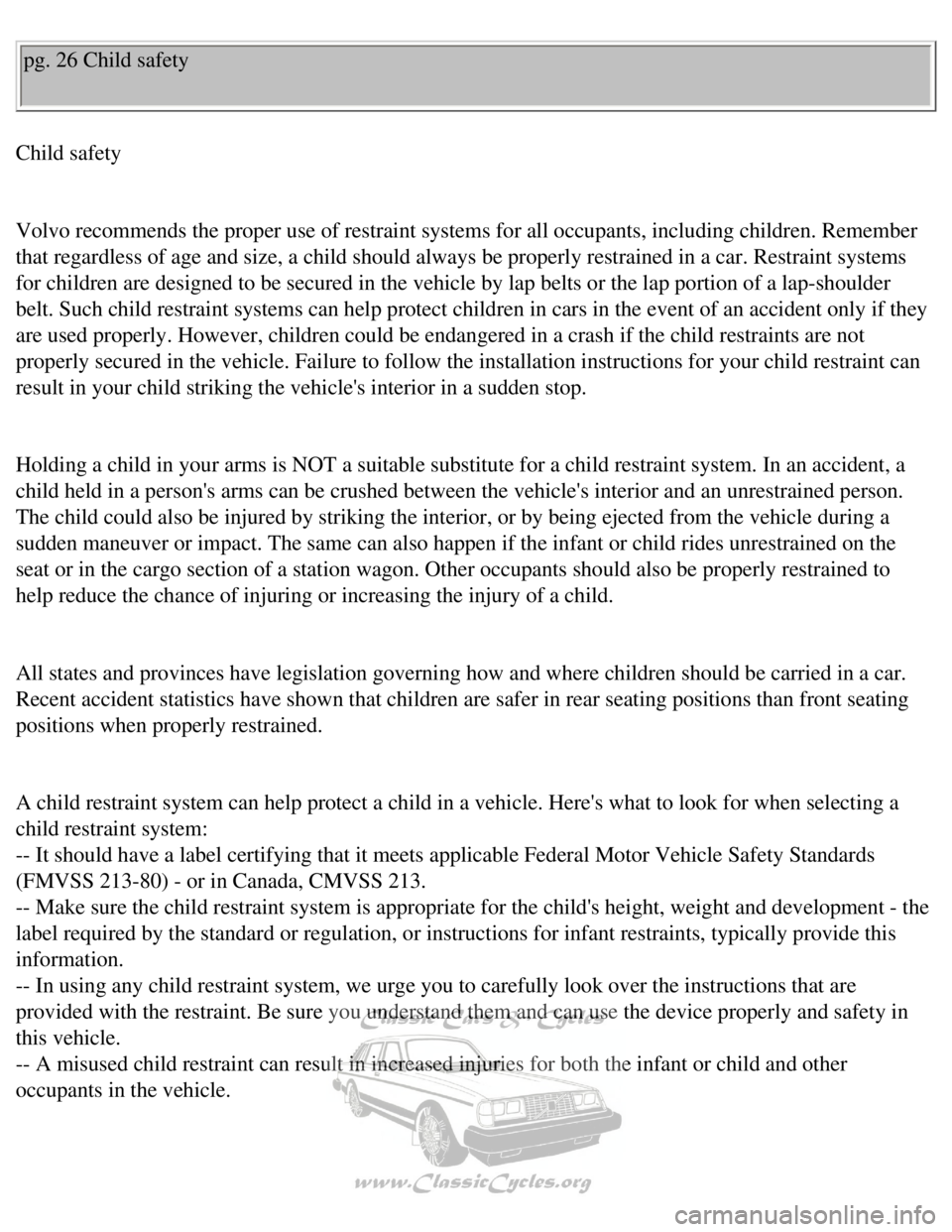
Volvo 1990 240 Model
pg. 26 Child safety
Child safety
Volvo recommends the proper use of restraint systems for all occupants, \
including children. Remember
that regardless of age and size, a child should always be properly restr\
ained in a car. Restraint systems
for children are designed to be secured in the vehicle by lap belts or t\
he lap portion of a lap-shoulder
belt. Such child restraint systems can help protect children in cars in \
the event of an accident only if they
are used properly. However, children could be endangered in a crash if t\
he child restraints are not
properly secured in the vehicle. Failure to follow the installation inst\
ructions for your child restraint can
result in your child striking the vehicle's interior in a sudden stop.
Holding a child in your arms is NOT a suitable substitute for a child re\
straint system. In an accident, a
child held in a person's arms can be crushed between the vehicle's inter\
ior and an unrestrained person.
The child could also be injured by striking the interior, or by being ej\
ected from the vehicle during a
sudden maneuver or impact. The same can also happen if the infant or chi\
ld rides unrestrained on the
seat or in the cargo section of a station wagon. Other occupants should \
also be properly restrained to
help reduce the chance of injuring or increasing the injury of a child. \
All states and provinces have legislation governing how and where childr\
en should be carried in a car.
Recent accident statistics have shown that children are safer in rear se\
ating positions than front seating
positions when properly restrained.
A child restraint system can help protect a child in a vehicle. Here's w\
hat to look for when selecting a
child restraint system:
-- It should have a label certifying that it meets applicable Federal Mo\
tor Vehicle Safety Standards
(FMVSS 213-80) - or in Canada, CMVSS 213.
-- Make sure the child restraint system is appropriate for the child's h\
eight, weight and development - the
label required by the standard or regulation, or instructions for infant\
restraints, typically provide this
information.
-- In using any child restraint system, we urge you to carefully look ov\
er the instructions that are
provided with the restraint. Be sure you understand them and can use the\
device properly and safety in
this vehicle.
-- A misused child restraint can result in increased injuries for both t\
he infant or child and other
occupants in the vehicle.
file:///K|/ownersdocs/1990/1990_240/90240_06.htm (1 of 9)12/30/2006 8:\
25:04 AM
Page 35 of 143
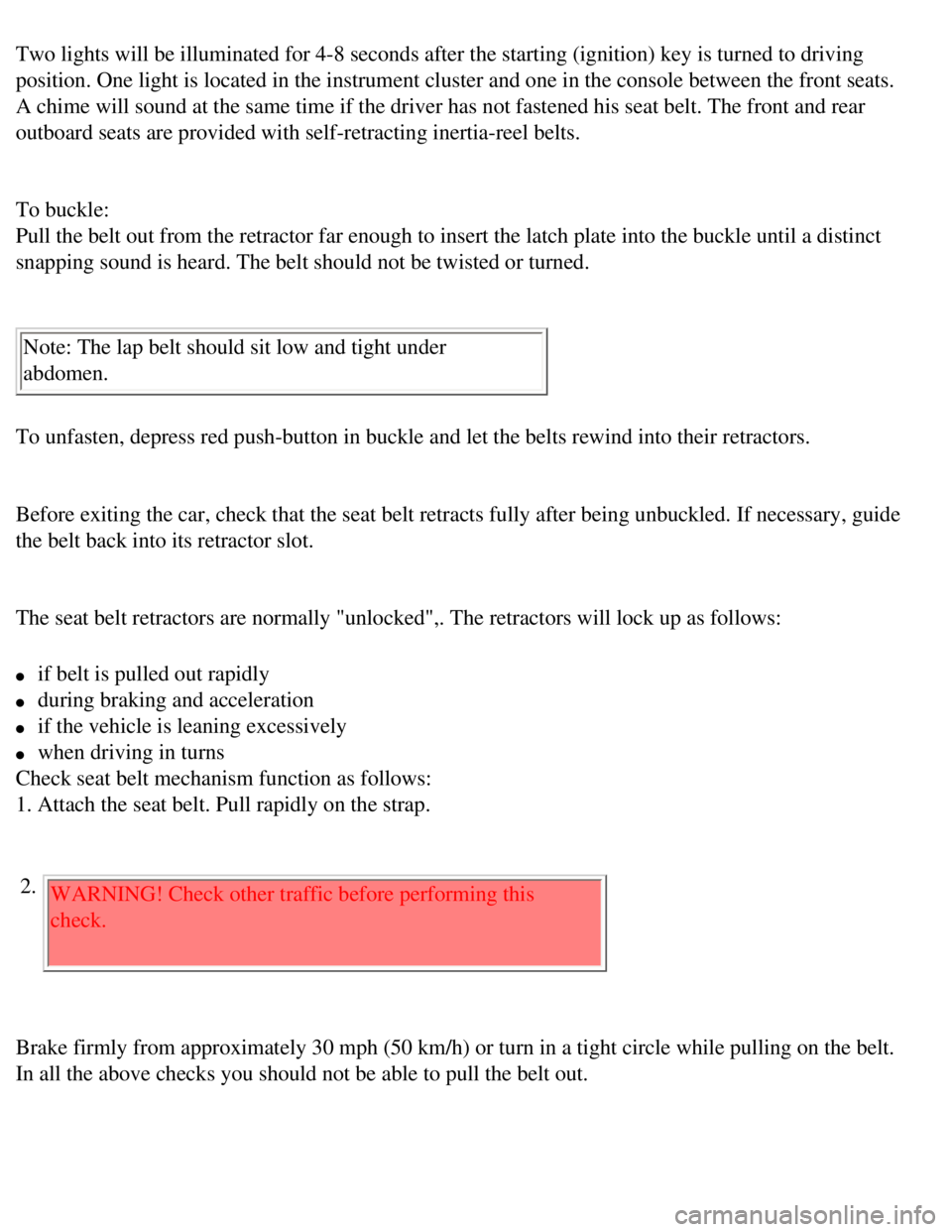
Volvo 1990 240 Model
Two lights will be illuminated for 4-8 seconds after the starting (igni\
tion) key is turned to driving
position. One light is located in the instrument cluster and one in the \
console between the front seats.
A chime will sound at the same time if the driver has not fastened his s\
eat belt. The front and rear
outboard seats are provided with self-retracting inertia-reel belts.
To buckle:
Pull the belt out from the retractor far enough to insert the latch plat\
e into the buckle until a distinct
snapping sound is heard. The belt should not be twisted or turned.
Note: The lap belt should sit low and tight under
abdomen.
To unfasten, depress red push-button in buckle and let the belts rewind \
into their retractors.
Before exiting the car, check that the seat belt retracts fully after be\
ing unbuckled. If necessary, guide
the belt back into its retractor slot.
The seat belt retractors are normally "unlocked",. The retractors will l\
ock up as follows:
l if belt is pulled out rapidly
l during braking and acceleration
l if the vehicle is leaning excessively
l when driving in turns
Check seat belt mechanism function as follows:
1. Attach the seat belt. Pull rapidly on the strap.
2. WARNING! Check other traffic before performing this
check.
Brake firmly from approximately 30 mph (50 km/h) or turn in a tight ci\
rcle while pulling on the belt.
In all the above checks you should not be able to pull the belt out.
file:///K|/ownersdocs/1990/1990_240/90240_06.htm (4 of 9)12/30/2006 8:\
25:04 AM
Page 37 of 143
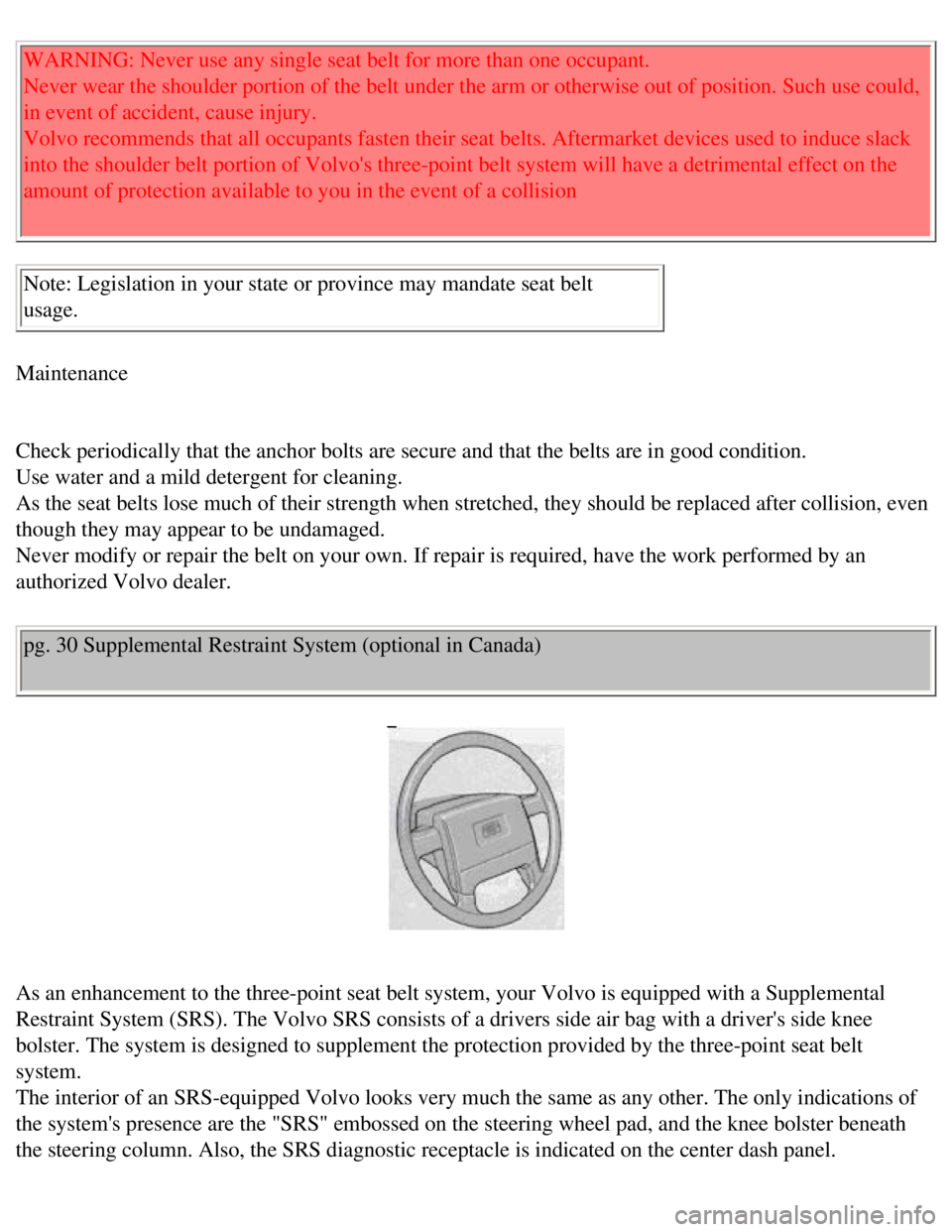
Volvo 1990 240 Model
WARNING: Never use any single seat belt for more than one occupant.
Never wear the shoulder portion of the belt under the arm or otherwise o\
ut of position. Such use could,
in event of accident, cause injury.
Volvo recommends that all occupants fasten their seat belts. Aftermarket\
devices used to induce slack
into the shoulder belt portion of Volvo's three-point belt system will h\
ave a detrimental effect on the
amount of protection available to you in the event of a collision
Note: Legislation in your state or province may mandate seat belt
usage.
Maintenance
Check periodically that the anchor bolts are secure and that the belts a\
re in good condition.
Use water and a mild detergent for cleaning.
As the seat belts lose much of their strength when stretched, they shoul\
d be replaced after collision, even
though they may appear to be undamaged.
Never modify or repair the belt on your own. If repair is required, have\
the work performed by an
authorized Volvo dealer.
pg. 30 Supplemental Restraint System (optional in Canada)
As an enhancement to the three-point seat belt system, your Volvo is equ\
ipped with a Supplemental
Restraint System (SRS). The Volvo SRS consists of a drivers side air b\
ag with a driver's side knee
bolster. The system is designed to supplement the protection provided by\
the three-point seat belt
system.
The interior of an SRS-equipped Volvo looks very much the same as any ot\
her. The only indications of
the system's presence are the "SRS" embossed on the steering wheel pad, \
and the knee bolster beneath
the steering column. Also, the SRS diagnostic receptacle is indicated on\
the center dash panel.
file:///K|/ownersdocs/1990/1990_240/90240_06.htm (6 of 9)12/30/2006 8:\
25:04 AM
Page 38 of 143
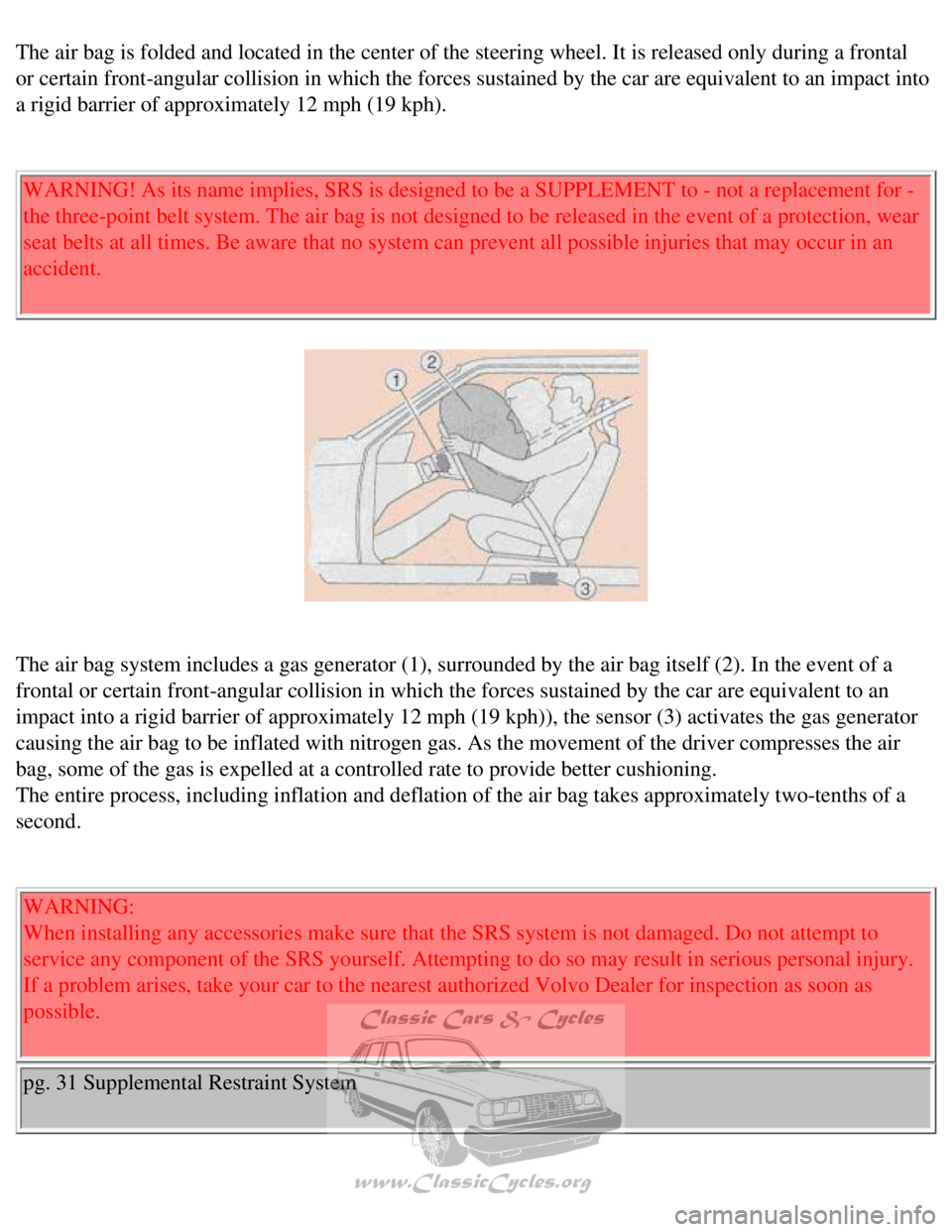
Volvo 1990 240 Model
The air bag is folded and located in the center of the steering wheel. I\
t is released only during a frontal
or certain front-angular collision in which the forces sustained by the \
car are equivalent to an impact into
a rigid barrier of approximately 12 mph (19 kph).
WARNING! As its name implies, SRS is designed to be a SUPPLEMENT to - no\
t a replacement for -
the three-point belt system. The air bag is not designed to be released \
in the event of a protection, wear
seat belts at all times. Be aware that no system can prevent all possibl\
e injuries that may occur in an
accident.
The air bag system includes a gas generator (1), surrounded by the air\
bag itself (2). In the event of a
frontal or certain front-angular collision in which the forces sustained\
by the car are equivalent to an
impact into a rigid barrier of approximately 12 mph (19 kph)), the se\
nsor (3) activates the gas generator
causing the air bag to be inflated with nitrogen gas. As the movement of\
the driver compresses the air
bag, some of the gas is expelled at a controlled rate to provide better \
cushioning.
The entire process, including inflation and deflation of the air bag tak\
es approximately two-tenths of a
second.
WARNING:
When installing any accessories make sure that the SRS system is not dam\
aged. Do not attempt to
service any component of the SRS yourself. Attempting to do so may resul\
t in serious personal injury.
If a problem arises, take your car to the nearest authorized Volvo Deale\
r for inspection as soon as
possible.
pg. 31 Supplemental Restraint System
file:///K|/ownersdocs/1990/1990_240/90240_06.htm (7 of 9)12/30/2006 8:\
25:04 AM
Page 39 of 143

Volvo 1990 240 Model
A self-diagnostic system incorporated in the sensor monitors the SRS. If\
a fault is detected, the "SRS"
warning light will illuminate. the light is included in the warning/indi\
cator light cluster in the instrument
panel. Normally, the SRS warning light will be illuminated along with th\
e other warning/indicator lights
when the ignition key is turned to the ON position (position II), and \
go out a short time after the engine
has been started. Check that this light is functioning properly every ti\
me the car is started.
The following items are monitored by the diagnostic system:
l Sensor unit electronics integrity.
l Reserve energy supply.
l Diagnostic output circuit.
l System voltage.
l Integrity of system connectors.
l Mercury switch closure.
l Gas generator ignitor
WARNING! If the SRS warning light stays on after the engine has started \
or if it comes on while you
are driving, drive the car to the nearest authorized Volvo Dealer for in\
spection as soon as possible.
ATTENTION! SRS VEHICLE!
THIS CAR IS EQUIPPED WITH A SUPPLEMENTAL RESTRAINT SYSTEM. TO PROVIDE
CONTINUED RELIABILITY, CERTAIN ELEMENTS OF THE SUPPLEMENTAL RESTRAINT
SYSTEM SHALL BE SERVICED OR REPLACED BY 1999. SEE OWNERS MANUAL FOR
FURTHER INFORMATION.
VOLVO
There is no maintenance to perform on the SRS yourself. The only periodi\
c maintenance recommended
on the SRS is that the air bag module and the sensor unit should be repl\
aced every ten years and that the
other components in the system (wiring, connectors, etc.) should also \
be inspected at this time. This
service must be performed by an authorized Volvo dealer.
file:///K|/ownersdocs/1990/1990_240/90240_06.htm (8 of 9)12/30/2006 8:\
25:04 AM